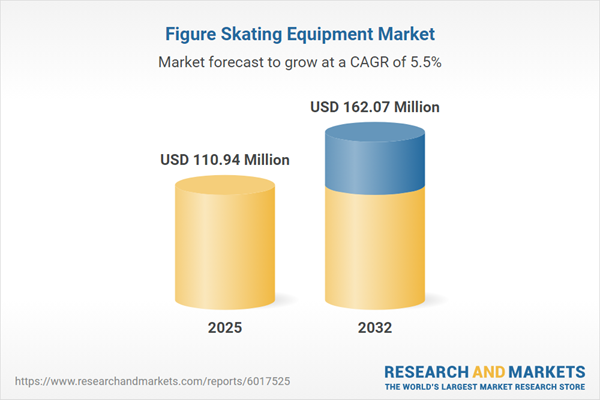Speak directly to the analyst to clarify any post sales queries you may have.
The figure skating equipment market is entering a pivotal phase, shaped by shifts in technology, end-user preferences, and geographic expansion. For senior decision-makers, understanding these dynamics is essential for developing strategies that maximize both resilience and long-term value.
Market Snapshot: Figure Skating Equipment Market Growth Trajectory
The global figure skating equipment market advanced from USD 105.73 million in 2024 to USD 110.94 million in 2025 and is projected to reach USD 162.07 million by 2032, reflecting a CAGR of 5.48%. This robust growth profile is driven by a combination of advanced product integration, increasing user engagement among both athletes and enthusiasts, and a strong focus on the customer experience. Ongoing innovation and broader market visibility are setting the stage for continued expansion and diversification across major continents.
Scope & Segmentation of the Figure Skating Equipment Market
- Product Type: Skates, apparel and costumes, tights and socks, protective gear such as helmets, shin guards, knee pads, elbow pads, wrist guards, and various accessories. Each type demonstrates innovation and an emphasis on user safety and individual performance enhancements across distinct skating profiles.
- Age Group: Youth, adult, and senior user segments. These segmentations enable tailored product design and marketing approaches for ergonomics and style preferences specific to each demographic group.
- Distribution Channel: eCommerce platforms, sporting goods stores, department stores, brand-owned websites, and ice skating rinks. A blend of digital and physical channels enhances product accessibility, reach, and support—facilitating adaptability within global and local markets.
- User Category: Male and female users. Segmenting by user category allows for products and campaigns that address both ergonomic comfort and stylistic appeal, supporting differentiated brand positioning.
- End User: Recreational, amateur, professional, elite competitive, and Olympic skaters. Targeting these groups ensures product development aligns with the spectrum of needs from technical innovation to comfort and value.
- Region: Markets in the Americas, Europe, Middle East, Africa, and Asia-Pacific are addressed, with strategic focus on the United States, Canada, Brazil, Germany, Russia, UAE, South Africa, China, and Australia. Regional customization enables nuanced engagement and competitive distribution strategies.
- Company Coverage: Leading providers include AURA Figure Skates, Bauer Hockey Inc., Bunga Pads, ChloeNoel, Decathlon SA, Graf Skates AG, Harlick Skates, Jackson Ultima, Jerry's Skating World Inc., John Wilson Blades, Mizuno Corporation, MK Blades, MONDOR, CCM Hockey, Riedell Shoe Inc., Risport Skates, SP-Teri Skates, ZÜCA Inc., Winnwell Inc, ROCES SPORT S.R.L., Paramount Sk8s Inc., and EDEA srl, representing a competitive supplier ecosystem.
Key Takeaways for Senior Decision-Makers
- Smart textiles, material advancements, and connected features are elevating competitive differentiation, enabling both manufacturers and users to capture new value opportunities.
- Environmental sustainability is reshaping supplier choices. Adoption of recycled materials and responsible manufacturing are building credibility and reinforcing long-term brand trust.
- Personalization and modular design options are more prominent as participation widens, prompting demand for adaptive equipment across age and skill groups.
- Traditional markets emphasize innovation and research-led collaboration, while emerging markets are developing skating infrastructure to broaden participation and fuel sustained demand.
- Digital sales channels are increasing in importance; however, service-driven retail outlets remain vital for premium transactions, informed support, and reinforcing brand presence.
- Procurement priorities are diverging: professionals value engineering quality and technical features, whereas less experienced skaters seek comfort and cost-efficiency.
Tariff Impact on Figure Skating Equipment Supply Chains
Recent modifications to United States tariffs are altering sourcing and manufacturing strategies, as domestic production gains appeal and supplier diversification becomes a priority. These changes influence pricing structures and require businesses to reassess cost-control measures. Local manufacturers may capitalize on increased demand, making scenario planning an essential tool for maintaining a competitive stance amid regulatory changes.
Methodology & Data Sources
This figure skating equipment market research draws on executive interviews, industry-specific surveys, and analysis of authoritative publications. The study applies regression analysis and SWOT frameworks, balancing qualitative viewpoints and quantitative findings to ensure well-validated insights for strategic planning.
Why This Report Matters: Strategic Benefits for Decision-Makers
- Offers clear guidance on product development, technology integration, and market entry strategies, supporting agile and informed decision-making for figure skating equipment suppliers and brand leaders.
- Highlights risks and emerging opportunities linked to regulatory trends, sustainability shifts, and evolving consumer profiles, empowering leadership to respond with data-backed strategies.
- Provides actionable, region-specific recommendations, strengthening investment readiness and supporting resilience against rapidly changing sector dynamics.
Conclusion: Navigating Forward in the Figure Skating Equipment Market
This research equips decision-makers with comprehensive insights and actionable recommendations, enabling businesses to optimize growth, enhance operational agility, and confidently navigate the evolving global market environment.
Additional Product Information:
- Purchase of this report includes 1 year online access with quarterly updates.
- This report can be updated on request. Please contact our Customer Experience team using the Ask a Question widget on our website.
Table of Contents
3. Executive Summary
4. Market Overview
7. Cumulative Impact of Artificial Intelligence 2025
Companies Mentioned
The companies profiled in this Figure Skating Equipment market report include:- AURA Figure Skates
- Bauer Hockey Inc.
- Bunga Pads
- ChloeNoel
- Decathlon SA
- Graf Skates AG
- Harlick Skates
- Jackson Ultima
- Jerry's Skating World Inc.
- John Wilson Blades
- Mizuno Corporation
- MK Blades
- MONDOR
- CCM Hockey
- Riedell Shoe Inc.
- Risport Skates
- SP-Teri Skates
- ZÜCA, Inc.
- Winnwell Inc
- ROCES SPORT S.R.L.
- Paramount Sk8s Inc.
- EDEA srl
Table Information
| Report Attribute | Details |
|---|---|
| No. of Pages | 191 |
| Published | November 2025 |
| Forecast Period | 2025 - 2032 |
| Estimated Market Value ( USD | $ 110.94 Million |
| Forecasted Market Value ( USD | $ 162.07 Million |
| Compound Annual Growth Rate | 5.4% |
| Regions Covered | Global |
| No. of Companies Mentioned | 23 |









